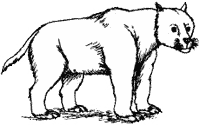- Bear dog
Taxobox
name = Amphicyonids
fossil_range =Eocene -Miocene

image_caption = Artist's reconstruction of abear dog .
regnum =Animal ia
phylum =Chordata
classis =Mammal ia
ordo =Carnivora
subordo =Caniformia
familia = Amphicyonidae
subdivision_ranks = Subfamilies
subdivision =Amphicyoninae Daphoeninae Thanmastocyoninae Bear dogs (amphicyonids) are extinct
Carnivora nmammals of the family Amphicyonidae that lived during the LateEocene toLate Miocene 37 to 9 Mya.Taxonomy
While the Amphicyonidae have traditionally been viewed as closely related to the
Ursidae (bears), some evidence suggests that they may instead be basal caniforms. (Hunt, 2004b). They were about as tall as theAmerican black bear and were most likely ambushers due to the fact that their legs were made for short, sudden bursts of speed. The bear-dog also nested their young in nests underneath the ground.During the early Miocene, a number of large amphicyonids migrated from
Eurasia intoNorth America . Thesetaxa belong to the Old World amphicyonid sub-family Amphicyoninae. The earliest to appear is the large beardog "Ysengrinia" Ginsburg, followed by "Cynelos" Jourdan, and then by "Amphicyon ". This influx of amphicyonines, accompanied by otherOld World ungulate s and small mammals, indicates a prolonged interval (from 23 to 16.5 Ma) offauna l exchange between Asia and North America in the early Miocene, using the trans-Beringia n route (Hunt, 2004a).New World daphoenines ("Daphoenodon", "Borocyon") andtemnocyonines coexisted with Old World amphicyonines ("Ysengrinia", "Amphicyon", "Cynelos") 23.7-17.5 million years ago. These are the largest terrestrial carnivorans (50–100 kg) that evolved on the North American continent up to this time. The immigrant amphicyonines "Ysengrinia", "Cynelos" and "Amphicyon" appear at 23, 19.2, and 18.8 Ma, respectively, and herald the beginning of a Eurasian amphicyonine migration into North America that continued into the mid-Miocene (Hunt, 2004b).Evolutionary history
Classification
* Family Amphicyonidae
** Subfamily Amphicyoninae
*** Genus Agnotherium
**** "A. antiquus"
**** "A. grivense"
*** GenusAmphicyon
**** "A. frendens"
**** "A. bohemicus"
**** "A. castellanus"
**** "A. caucasicus"
**** "A. galushai"
**** "A. giganteus"
**** "A. ingens"
**** "A. intermedius (type)"
**** "A. laugnacensis"
**** "A. longiramus"
**** "A. major"
**** "A. pontoni"
**** "A. reinheimeri"
**** "A. riggsi"
**** "A. tairumensis"
**** "A. ulungurensis"
*** Genus Amphicyonopsis
**** "A. serus"
*** Genus Brachycyon
**** "B. reyi"
**** "B. palaeolycos"
**** "B. gaudryi"
*** Genus Cynelos
**** "C. caroniavorus"
**** "C. crassidens"
**** "C. helbingo"
**** "C. idoneus"
**** "C. jourdan"
**** "C. lemanensis"
**** "C. pivetaui"
**** "C. rugosidens"
**** "C. schlosseri"
**** "C. sinapius"
*** GenusCynodictis
**** "C. lacustris"
*** Genus Euroamphicyon
**** "E. olisiponensis"
*** Genus Gobicyon
**** "G. macrognathus"
**** "G. zhegalloi"
*** Genus Guangxicyon
**** "G. sinoamericanus"
*** Genus Haplocyon
**** "H. elegans"
**** "H. crucians"
*** Genus Haplocyonoides
**** "H. mordax"
**** "H. serbiae"
**** "H. ponticus"
*** Genus Haplocyonopsis
*** Genus Harpagocyon
*** Genus Heducides
*** Genus Ischyrocyon
**** "I. gidleyi"
*** Genus Paradaphoenus
**** "P. cuspigerus"
**** "P. minimus"
**** "P. tooheyi"
*** Genus Pericyon
*** Genus Pliocyon
**** "P. medius"
**** "P. robustus"
*** Genus Proamphicyon
*** Genus Protemnocyon
*** Genus Pseudarctos
**** "P. bavaricus"
*** Genus Pseudamphicyon
**** "P. bavaricus"
*** Genus Pseudocyon
**** "P. sansaniensis"
**** "P. steinheimensis"
**** "P. styriacus"
*** Genus Pseudocyonopsis
**** "P. ambiguus"
**** "P. antiquus"
**** "P. quercensis"
*** Genus Symplectocyon
*** Genus Ysengrinia
**** "Y. americanus"
**** "Y. depereti"
**** "Y. geraniana"
**** "Y. ginsburg"
**** "Y. tolosana"
** Subfamily Daphoeninae(North America)
*** Genus Adilophontes
**** "A. brachykolos"
*** Genus Borocyon
*** Genus Brachyrhyncocyon
**** "B. dodgei"
**** "B. montanus"
*** Genus Daphoenictis
**** "D. tedfordi"
*** Genus Daphoenodon
**** "D. falkenbachi"
**** "D. notionastes"
**** "D. robustum"
**** "D. periculosus"
**** "D. skinneri"
**** "D. superbus"
*** GenusDaphoenus
**** "D. dodgei" or "Daphoenocyon dodgei"
**** "D. felinus"
**** "D. hartshornianus"
**** "D. inflatus"
**** "D. lambei"
**** "D. nebrascensis"
**** "D. socialis"
**** "D. transversus"
**** "D. vetus"
*** Genus Paradaphoenus
**** "P. cuspigerus"
**** "P. minimus"
**** "P. tooheyi"
** Subfamily Temnocyoninae(North America)
*** Genus Mammacyon
**** "M. obtusidens"
*** Genus Temnocyon
**** "T. altigenis"
**** "T. ferox"
**** "T. percussor"
**** "T. venator"
** Subfamily ThanmastocyoninaeReferences
* Hunt, Robert M, Jr. (2004a) "Intercontinental Migration of Large Mammalian Carnivores: Earliest Occurrence of the Old World Beardog Amphicyon (Carnivora, Amphicyonidae) in North America." in Cenozoic Carnivores and Global Climate by Robert M. Hunt, Jr. [http://digitallibrary.amnh.org/dspace/bitstream/2246/447/23/B279a04.pdf]
* Hunt, Robert M, Jr. (2004b) "Global Climate and the Evolution of Large Mammalian Carnivores during the Later Cenozoic in North America" in Cenozoic Carnivores and Global Climate by Robert M. Hunt, Jr. [http://digitallibrary.amnh.org/dspace/bitstream/2246/453/8/B285a11.pdf]ee also
*
Bear
*Canidae
*Waheela External links
Wikimedia Foundation. 2010.
